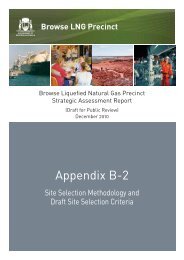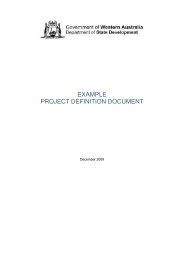Browse LNG Precinct - Public Information Booklet - Department of ...
Browse LNG Precinct - Public Information Booklet - Department of ...
Browse LNG Precinct - Public Information Booklet - Department of ...
You also want an ePaper? Increase the reach of your titles
YUMPU automatically turns print PDFs into web optimized ePapers that Google loves.
<strong>Public</strong> <strong>Information</strong> <strong>Booklet</strong><br />
Figure 33: Jetty construction<br />
Question ñ How big will the breakwater be and what will it be made from?<br />
The marine concepts are not yet finalised and are dependent on the selected site and<br />
ocean conditions at that location. However, based on the information that has been<br />
collected there is likelihood for a breakwater to protect the <strong>LNG</strong> loading berth. This<br />
breakwater is expected to be in approximately 12 to15 metres (13 to 16 yards) <strong>of</strong> water<br />
depth. The length and orientation <strong>of</strong> the breakwater will be governed by the site location<br />
and marine facilities layout (including jetty, channel etc). No decision has been made on<br />
the type <strong>of</strong> breakwater.<br />
Studies have identified a shortage <strong>of</strong> suitable breakwater armour rock in the region, and a<br />
preference to use a prefabricated concrete caisson breakwater, eliminating the need for<br />
armour rock. A caisson is a large concrete block (built by connecting multiple large<br />
concrete cylinders) that can be floated into place and sunk onto the seabed. A series <strong>of</strong><br />
these when combined together and when completed will be similar size to a rock type<br />
breakwater.<br />
5279225 64









